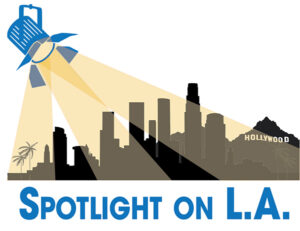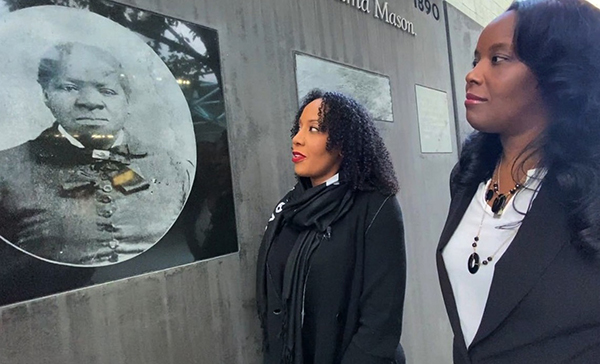By Darlene Donloe
Contributing Writer
Behind the Bradbury Building in a courtyard off Broadway and Spring streets, between 3rd and 4th Streets in downtown Los Angeles, is a mini-park dedicated to a slave who won her freedom in court, became a nurse and midwife, a philanthropist and property owner, eventually becoming one of L.A.’s most prominent, revered and successful citizens.
Her name is Bridget ‘Biddy’ Mason, and her remarkable story is one of resilience and determination, worthy of the park named in her honor.
It’s not surprising that most Los Angeles residents have never heard of the Biddy Mason Memorial Park. It isn’t a well-known Los Angeles landmark. In fact, if you don’t know it’s there, you don’t know it’s there.
You’re liable to walk right past it — as many do on any given day.
“It’s interesting that it’s unknown and kind of hidden,” said Sana Ahmed, L.A. Conservancy student, and family program manager. “It was created for the opposite reason. The founders, all women, felt that the location between Broadway and Spring Street would be a popular thoroughfare as well as the location of where her home once stood.”
The Los Angeles Conservancy is a member-based nonprofit organization whose mission is to recognize, preserve and revitalize the historic architectural and cultural resources of Los Angeles County.
Ahmed, who has been with the agency for five years, said “the way the city has changed has brought people away from the location.”
“People don’t make the extra turn around the corner where the park is located,” Ahmed said. “It’s not visible from the street. It may be confusing for some people.”

Cheryl Cox, a great-granddaughter of Mason, said she doesn’t “feel that the Biddy Mason Memorial Park, by itself, is an adequate tribute” to her grandmother.
“It is rare that people of color are honored for their contributions and women of color, even less so,” said Cox, co-founder of The Biddy Mason Foundation. “While we appreciate the effort that the city made, almost 100 years after her death, it is literally a wall hidden in a parking structure.
“Grandma Biddy was a living legend in Los Angeles during her time. She was instrumental in the development of Los Angeles and laid the groundwork that made this city what it is today. This extraordinary woman, who accomplished unbelievable feats, at a time that was unconscionable for a former slave deserves at minimum a street named after her. Our family is currently petitioning the city to rename at least a portion of Spring Street after her.”
It was recently announced that the Women’s March Foundation is campaigning for streets across the country to be named after Maya Angelou, Gloria Steinem, Ruth Bader Ginsburg and Mason.
“People of African descent have played a major role in the founding and development of Los Angeles and California from the very beginning,” said Robynn Cox, another great-granddaughter of Mason and sister of Cheryl Cox. “However, less is known or acknowledged about this history, including that of Grandma Biddy. It is important to make her contributions, and others like her, known when retelling the history of California in general, and Los Angeles in particular.
“Because Blacks make up such a small proportion of the population today, it is important for Black children growing up in California to not only see themselves in its history but also to know that people who looked just like them helped to build the foundation of their community.”
The Biddy Mason Memorial Park is located in downtown Los Angeles and, while the tribute is appreciated and deserved, unfortunately, the site is void of any signage publicizing its out-of-the-way location.
For those who do make their way to the intimate site, they will be able to read about Mason’s incredible story, told through intricate timeline wall sketches that outline her life’s struggles, altruism, and accomplishments.
“Biddy Mason is more than just a story of an early Los Angeles pioneer, she is an American story,” said Robynn Cox, an assistant professor at USC. “Grandma Biddy provides a clear example of the promise of what America could be if it were to remove systemic barriers that continue to oppress historically marginalized groups.
“Ultimately, Biddy Mason is a living demonstration of how great this country could be if it were to honor its principles of equality and justice for all, and actually guarantee that Black Lives Do Matter. She is an example of what Black people can accomplish when given the opportunity to be great.”
The Biddy Mason Memorial Park was designed by landscape architects Katherine Spitz and Pamela Burton.
A corner by the elevators has a Betye Saar piece representing the wood-frame house. The plaza has an 80-foot-long poured concrete wall by Sheila Levrant de Bretteville with a timeline of Mason’s life, as well as simple text and images such as an early survey map of Los Angeles and Mason’s freedom papers.
The tribute starts at the end of the wall with the text “Biddy Mason born a slave” and ends with “Los Angeles mourns and reveres Grandma Mason.”
There are impressions of a wagon wheel, an agave leaf and a midwife’s black bag inset into the concrete.
The LA Conservancy includes the memorial park in its historic downtown walking tour, which takes place on Saturdays at 10 a.m.
“We started it 30 years ago,” Ahmed said. “It’s our ending location on the tour — to share the place as a part of historic downtown’s history, but also a place that we would like to bring awareness to — to honor Biddy Mason’s life and the story that she represents.”
Ahmed said Mason’s story encapsulates all the chapters that are important to L.A. history.
“The park is a place that is important to Black history in Los Angeles,” Ahmed said. “Her story is equally important to women’s history, civil rights history, and urban landscape history in Los Angeles. We are proud to include the space in our walking tour.”
Ahmed said the student walking tours for students between the third and 12th grades also end at the park. She stresses that the location of the park is “safe and accessible.”
“It’s not a private park,” Ahmed said. “There are pathways and no steps. It’s appropriate for all abilities to walk through. It’s a nice refuge from the busy streets.”
A tombstone was laid at the Biddy Mason Memorial Park site on March 27, 1988, by then-Mayor Tom Bradley, the first Black mayor of Los Angeles, and several thousand members of the First African Methodist Episcopal church. A year later, Nov. 16, 1989, was observed as “Biddy Mason Day” in Los Angeles.
The site is also the location of the land Mason purchased in the heart of downtown Los Angeles.
Mason, who was affectionately known as “Grandma Mason,” was, reportedly, born a slave in Mississippi on Aug. 15, 1818.
Her last owner was a man named Robert Marion Smith, a Mississippi Mormon convert. Following the call of the church, Smith moved his family and enslaved persons to the West where he helped establish a Mormon community in what would become Salt Lake City, Utah.
In 1848, Mason, then 30, reportedly walked 1,700 miles behind a 300-wagon caravan. The caravan eventually arrived in the Holladay-Cottonwood area of the Salt Lake Valley. Along the route, Mason was reportedly responsible for setting up and breaking camp; cooking the meals; herding cattle; and serving as a midwife. She also took care of her three young daughters, ages 10, 4, and a newborn.
After her master relocated to San Bernardino, and after spending five years enslaved in California, Mason petitioned for her own freedom in Los Angeles court, as it was a free state. L.A. District Judge Benjamin Hayes approved her petition on Jan. 21, 1856. The ruling freed Mason and 13 members of her extended family.
The story goes that after a land dispute that led to her owner, Smith, quitting the Mormon church and preparing to return to pro-slavery Texas, someone ratted him out to authorities and a writ of habeas corpus compelled him to prove his slaves were leaving for a slave state willingly.
After a district judge issued a pre-trial opinion on Jan. 19, 1856, that Mason and the other slaves were “entitled to their freedom and are free forever,” Smith reportedly skipped town, ending the case.
After her freedom was granted, Mason stayed in Los Angeles where she found work as a nurse and midwife with Dr. John Griffin, a white physician. She gave time and money to charities, the poor and the imprisoned.
She became a real estate entrepreneur one of the first African Americans to purchase land in Los Angeles in the 1850s and 1860s, was instrumental in establishing the first elementary school for Black children in Los Angeles, and was a founding member of the First A.M.E. Church in Los Angeles in 1872.
Mason died in Los Angeles on Jan. 15, 1891, at the age of 72 and is buried in Evergreen Cemetery in Boyle Heights. Her estate was reportedly worth $300,000 (the equivalent today of $8.5 million).
Biddy Mason Park is located at 331 S. Spring St., in downtown Los Angeles.
“Spotlight on L.A.” is a new feature profiling little-known places within the city. To propose a location for “Spotlight on L.A.,” send an email to dwanlass@wavepublication.com.
Darlene Donloe is a freelance reporter for Wave Newspapers who covers South Los Angeles. She can be reached at ddonloe@gmail.com.













